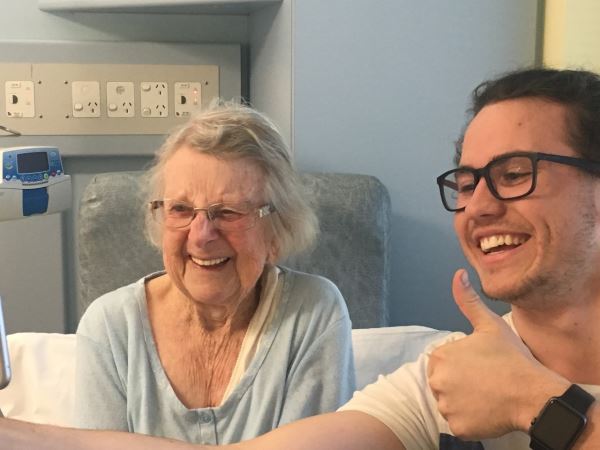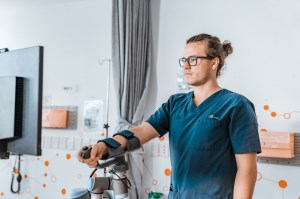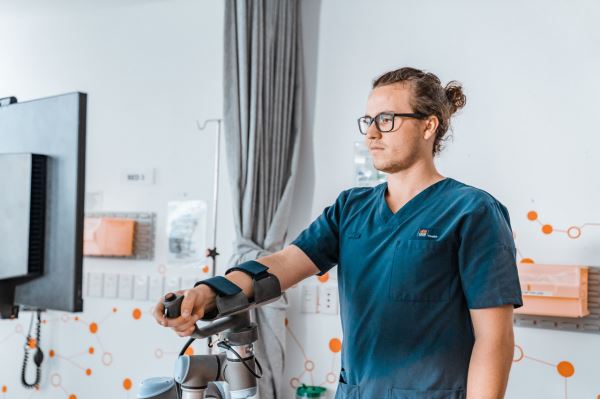About three years ago, Rowan Smith’s elderly grandma, Lorna suffered a stroke which left her in need of intensive regular physiotherapy to help reconnect her brain to her body.
Finding qualified physio and occupational therapists to make regular visits to her home on the NSW Central Coast was always going to be a major challenge.
This meant family members would be needed almost daily to ensure Lorna received the treatment needed to make a full recovery.
It’s a sad fact that about 65% of stroke patients return home with upper limb deficits, which means they cannot perform functional tasks.
“Having her independence back was so important to my nan,” Rowan explains. The therapy that one needs to undergo is physically intense – both for patients and therapists.”
Adding to both staff and patient woes was the monotonous nature of the therapy.
“It’s repetitive and offers no intellectual engagement,” he says.
“For example, a patient could sit trying to fasten and loosen a button for up to an hour”.
This was a light bulb moment for 25-year-old Rowan.
He recognised an urgent need to give patients like his “nan” easier access to physical therapy by using technology.
Why not use collaborative robots to perform similar monotonous, highly repetitive physical tasks, he thought?
Tech Gym a real game-changer
At the time, Rowan was studying Mechanical and Mechatronics at the University of Technology Sydney (UTS).
Co-incidentally, just weeks after his grandma had the stroke, he was invited to take part in a newly launched robotic rehabilitation course at UTS.
“This was a ‘serendipitous’ moment in my life,” Rowan recalls. “One of my luckiest moments".
The timing was perfect.
UTS had just received four UR3E collaborative robots (cobots) from Universal Robots, a global leader in collaborative robot technology.
“We spent six weeks exploring their capabilities and developing a prototype,” Rowan says.
In late 2018, he launched a startup called Tech Gym, aimed at supporting patients needing upper limb rehabilitation.
During the product development phase, his small team of engineers and interns from UTS and UNSW, worked closely with specialist physio, clinical and occupational therapists.
Rowan and the team developed a prototype that can hold and move the patient’s arm around in a cast while the patient is passive.
Helping patients return home faster
By using cobots to supplement rehabilitative care the team is hoping to increase the number of hours of physiotherapy a week a patient receives.
It will also help patients to return home faster with higher levels of independence.
Globally, the World Health Organisation (WHO) reports that an estimated 2.4 billion people are currently living with a health condition that benefits from rehabilitation.
In Australia alone, about 500,000 people live with the effects of a stroke. This is predicted to surge to one million people by 2050.
Further, there are only 65,000 physio and occupational therapists on-hand to assist with every type of injury for both children and adults.
“This is where Tech Gym comes in,” says Rowan.
“I studied engineering to make a difference and soon realised that I could play a key role in addressing this fundamental issue.”
Robotics and rehabilitation
Tech Gym has incorporated intelligent programming, courtesy of Universal Robots’ software tools, which were easy to use and quick to deploy.
James McKew, Regional Director APAC, Universal Robots, praised Tech Gym’s mission to provide human rehabilitation through robotics.
“We want to support them as much as we can,” he told Inside Robotics.
The biggest advantage of using the UR3E cobot in this project is the “inherent safety and ease of use,” he said.
“The robot is incredibly easy to program and very adaptable.
“It can also be deployed very quickly – that is key.
“In our opinion it’s the best and safest collaborative robot in the world.”
Taking treatment to the next level
The Tech Gym team has now developed an upgraded model by adding sensors.
In this way, cobots can be set up in-line with where the patient is in their rehabilitation journey. For instance, if a patient requires more resistance in the various movements, this can be achieved.
And more recently, an intuitive cast was developed.
“If the patient can complete a small range motion, then the cast enables them to reach a further frame of motion,” says Rowan.
“This continues to advance, both in movement and the quality of movement, throughout the journey to recovery.”
Freedom of movement
The degree of freedom of movement combined with the fact that you can move it into unique positions allows cobots to easily mimic human movements.
Beyond the physical capabilities, Rowan believes the new technology instils confidence in patients.
“We wanted to make the therapy fun and interactive,” he says.
“Programs include a range of everyday tasks such as cooking, cleaning, and driving.”
And due to flexibility of Tech Gym’s design, units are mobile and can be wheeled from one patient to another. “In addition, staff can be easily trained on how to use Tech Gym in a matter of minutes.”
While most patients now receive rehabilitation at hospitals and other medical facilities, there will be a rapid shift over the next five years for treatment to be carried out in homes, Rowan predicts.
“We are seeing a trend for more ‘inpatients’ and fewer outpatients.”
Moving forward
However, one of the biggest challenges is the adoption of such technologies, says Rowan.
“Getting the medical facility to embrace Tech Gym as a worthy alternative is not without its challenges.”
Nonetheless, Tech Gym has received their clinical trial after two years of R&D and their prototype is now ready to be trialled at a South Western Sydney Hospital.
“These tests will establish the feasibility of robotics in treating stroke patients,” Rowan says.
Cost is another major challenge – each unit can cost up to $50,000 including programming and deployment.
However, moving forward, Rowan believes these costs can be reduced substantially as the technology advances and demand increases.
Eventually, Rowan hopes the new technology can be used to help rehabilitate a broad variety of patients including those with brain and spinal cord injuries, multiple sclerosis (MS), arthritis, shoulder reconstruction – and even sporting injuries.
“Our vision for the future is to become a robotics leader for hospital and home rehabilitation to improve the lives of one billion people over the company’s lifetime.”
Tech Gym is currently raising capital to take the ambitious venture to the next level.
Rowan hopes to raise $1.25 million across two funding rounds – the springboard needed to take project to market.
Part of the funding will go toward running further pilot studies with stroke patients later this year.
For investment applications and inquiries contact:
Or you can learn more here:
Rowan reports his grandma Lorna (now 96 years-old) is healthy and progressing well since the stroke three years ago.


